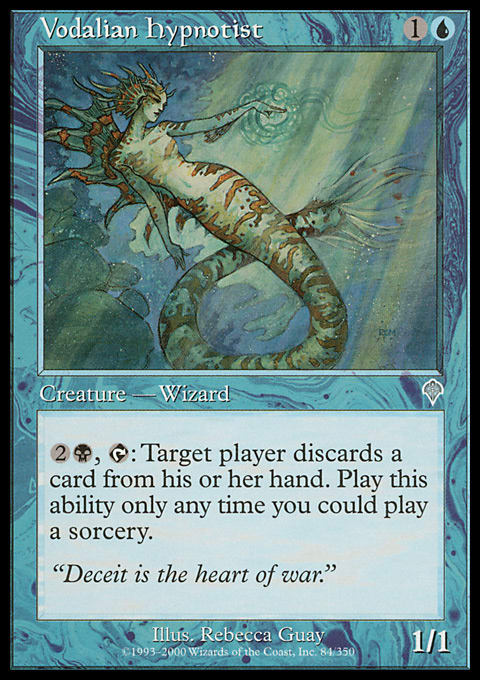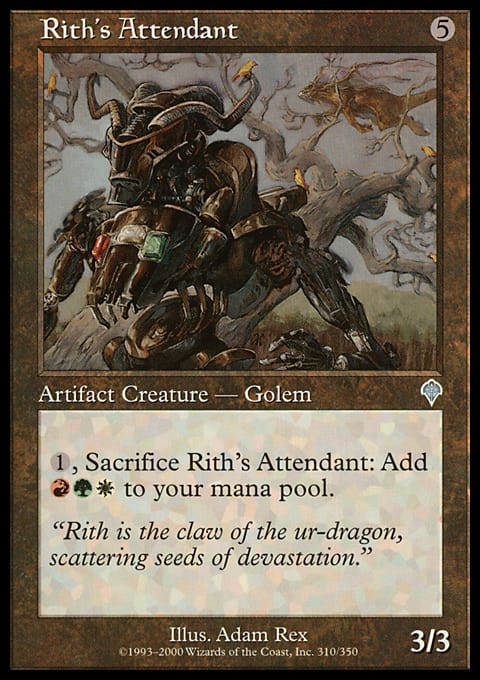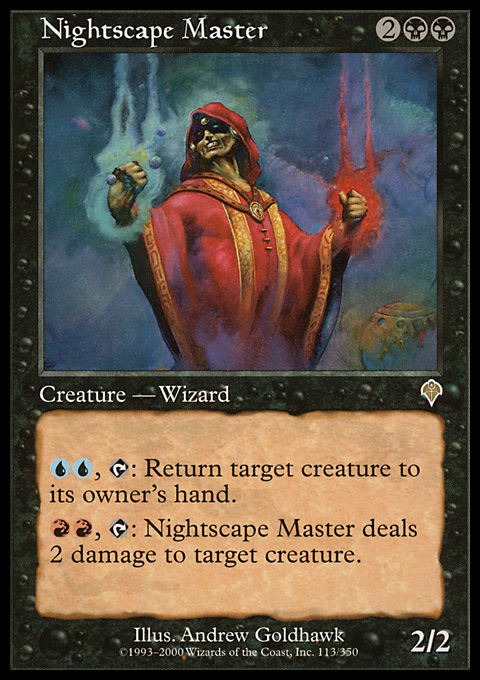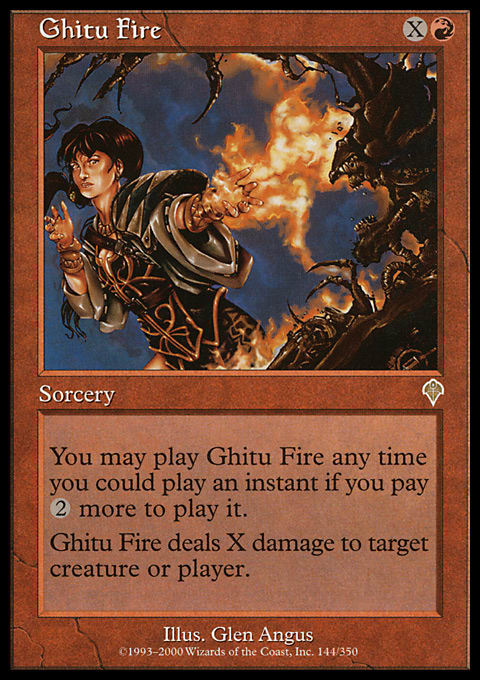I’ve been in the process of rating uncommon and rare cycles for a while now. It started here, and I’ve written up through Mercadian Masques. Now it’s time to tackle the cycles of Invasion block, the multicolored theme of which lends itself to so many cycles that I’ll have to be covering Planeshift and Apocalypse next week.
Why am I investigating cycles at all? Simply put, cycles are vital to Magic. If you understand Card X, it should help you understand Cards V, W, Y, and Z, teaching you five cards for the price of one. Similarly, a lot of sets are marketed around their cycles. Planeswalkers and Titans would be marketable by themselves, but a cycle makes them more memorable both individually and collectively.
So, I’m looking at horizontal cycles of at least five cards (think Titans rather than Penumbra Bobcat/Kavu/Wurm) for how they’ve done through the years. I rate cycles by:
- Playability – Does this have any cards people want to play?
- Depth – Was it hit-and-miss or strong overall?
- Resonance – Memorable cycles should be able to pass the flavor test, although some cycles are mechanical and are not intended to have shared flavor. Still, making all the cards cost the same, have similar names, or share other characteristics can make a cycle memorable when it otherwise wouldn’t be.
Although I’ll look at some cycles with commons, they can’t be all commons; this is the Gust-Skimmer Rule in honor of a cycle I have no words for. Also, I’m not covering land or artifact mana cycles for basically the same reason; how much can I say about Woodland Cemetery versus Llanowar Wastes versus Overgrown Tomb? I’m supposed to try to keep your interest, not write about lands.
Invasion has ten cycles to write about, and Invasion block has twenty. No other pre-Modern set exceeds eight such cycles, while no other pre-Ravnica block exceeds eighteen. So, this is a good GatheringMagic debut for talking about cycles. But enough yapping . . . on to more yapping!
The Emissaries
(Benalish Emissary, Tolarian Emissary, Urborg Emissary, Shivan Emissary, Verduran Emissary)
Playability: B−
Depth: A
Resonance: B
Each of these Wizards costs ![]() C (
C (![]() and 1 mana of a color) with a
and 1 mana of a color) with a ![]() D kicker of the color to its left on the color wheel. Urborg Emissary has a blue kicker and bounces a permanent, but the others destroy a permanent—Benalish Emissary being the strangest for being a white creature that can destroy a land. None of them is great, but they’re passable at Commander depth, maybe for a deck that wants to sacrifice the creature afterward. They’re all playable, and the names, converted mana costs, and kicker costs make this an easy cycle to pick up on and appreciate. A fine job.
D kicker of the color to its left on the color wheel. Urborg Emissary has a blue kicker and bounces a permanent, but the others destroy a permanent—Benalish Emissary being the strangest for being a white creature that can destroy a land. None of them is great, but they’re passable at Commander depth, maybe for a deck that wants to sacrifice the creature afterward. They’re all playable, and the names, converted mana costs, and kicker costs make this an easy cycle to pick up on and appreciate. A fine job.
Let’s Go the Other Way
(Benalish Heralds, Vodalian Hypnotist, Trench Wurm, Firebrand Ranger, Treefolk Healer)
Playability: C
Depth: B−
Resonance: C
These creatures have activated abilities of a color to that creature’s right on the color wheel. On average, this cycle is fatter than most creatures with those abilities—Trench Wurm is a 3/3 Dwarven Miner for ![]()
![]() —but I’m not sure that makes them worth it to most decks. Benalish Heralds might be the best one for being a 2/4 with card-draw; its Soldier creature type’s good, too. Otherwise, I’m ambivalent. Unlike the Emissaries, there isn’t flavor tying these together; they just exist as a cycle.
—but I’m not sure that makes them worth it to most decks. Benalish Heralds might be the best one for being a 2/4 with card-draw; its Soldier creature type’s good, too. Otherwise, I’m ambivalent. Unlike the Emissaries, there isn’t flavor tying these together; they just exist as a cycle.
The Weavers
(Spirit Weaver, Sky Weaver, Hate Weaver, Rage Weaver, Might Weaver)
Playability: C
Depth: A−
Resonance: B+
This is a great cycle to look nice in your binder. They’re 2/1s for ![]() C and can activate to benefit a creature on either side of its color. They also are Wizards with flavor text in the form of “Let my noun verb your other noun,” so it’s clear what’s going on. They’re just playable enough to have been reprinted together in Tenth Edition, but I find the effects too minor to bother with. You could use Training Grounds or Heartstone to make the activations cost
C and can activate to benefit a creature on either side of its color. They also are Wizards with flavor text in the form of “Let my noun verb your other noun,” so it’s clear what’s going on. They’re just playable enough to have been reprinted together in Tenth Edition, but I find the effects too minor to bother with. You could use Training Grounds or Heartstone to make the activations cost ![]() instead of
instead of ![]() —Hate Weaver’s firebreathing to blue or red creatures beckons—but that’s about it. Regardless, it’s important to have cycles for set comprehension, and the Weavers do that job nicely.
—Hate Weaver’s firebreathing to blue or red creatures beckons—but that’s about it. Regardless, it’s important to have cycles for set comprehension, and the Weavers do that job nicely.
The Djinns
(Ruham Djinn, Zanam Djinn, Goham Djinn, Halam Djinn, Sulam Djinn)
Playability: C
Depth: B
Resonance: B
Each of these ![]() C Djinns is a great beater unless its color is the most common color of permanents, in which case it gets -2/-2 and is annoyingly overcosted. The only one I’d try is Zanam Djinn since a 3/4 flyer for
C Djinns is a great beater unless its color is the most common color of permanents, in which case it gets -2/-2 and is annoyingly overcosted. The only one I’d try is Zanam Djinn since a 3/4 flyer for ![]()
![]() will do more in the average circumstance than a 3/3 first striker or 4/4 trampler. I suppose Goham Djinn’s being either a 3/3 or 5/5 that regenerates for
will do more in the average circumstance than a 3/3 first striker or 4/4 trampler. I suppose Goham Djinn’s being either a 3/3 or 5/5 that regenerates for ![]()
![]() isn’t terrible, but . . . meh. You have better options unless you’re building Djinn tribal. If you are, that’s awesome, although that awesomeness doesn’t improve this cycle.
isn’t terrible, but . . . meh. You have better options unless you’re building Djinn tribal. If you are, that’s awesome, although that awesomeness doesn’t improve this cycle.
The Attendants
(Dromar's Attendant, Crosis's Attendant, Darigaaz's Attendant, Rith's Attendant, Treva's Attendant)
Playability: B−
Depth: A
Resonance: B−
These Golems are 3/3s that sacrifice for 1 to give you the colored mana necessary to cast the Dragon each golem attends, with flavor text saying why each Golem cares about its Dragon. (Wasn’t “I Care About My Dragon” an SPCA campaign around 1994?) What I don’t understand is why each Dragon cares about having a Golem around. Maybe that’s in the storyline or something, but the flavor seems off. That’s okay in its way—the main point of the cycle clearly is to up the chances you cast your bombs in Limited—but that doesn’t make it a good cycle. Most of their playability has been eclipsed by Fifth Dawn’s Composite Golem anyway. I can see a Jund Commander deck reusing Darigaaz's Attendant—same with Sharuum the Hegemon and Dromar's Attendant—but they don’t scream for inclusion . . . or whatever sound a Golem would make for inclusion.
The Split Cards
(Stand // Deliver, Spite // Malice, Pain // Suffering, Assault // Battery, Wax // Wane)
Playability: B
Depth: B
Resonance: A
Split cards are about as iconic as a non-Timmy cycle can get, resonant despite the lack of flavor text or establishment of story. As spells with options, they’re presumed playable, but Spite // Malice and Assault // Battery stand out to me for utility in a vacuum. Countering a noncreature spell or destroying a nonblack creature covers most of what you might see in a game, and for that flexibility, I’m all right paying 4 mana for either half. Similarly, a sorcery Shock is fine if I can make an Elephant instead. Wax // Wane’s options as a pump spell or a Demystify have a nice gotcha factor given that both cost only 1 mana.
But more importantly for this review, they look cool. They make you want to play them for looking so cool, even as that head tilt at your hand gives away their presence. For being uncommon spells with minor effects on each side, they did their job as a cycle beautifully, and the design returned in later blocks. Well done, cycle.
The Leeches
(Alabaster Leech, Sapphire Leech, Andradite Leech, Ruby Leech, Jade Leech)
Playability: D
Depth: B (They’re all bad!?)
Resonance: C
So, these are gem-encrusted Leeches (not the card Leeches, mind you) that are undercosted with the drawback of making spells of their colors cost 1 more of that color to cast. From the flavor texts, we learn that Tolaria was researching these Leeches for something. Why? No idea. Why does the awesomeness of a first-turn 1/3 make Swords to Plowshares cost ![]()
![]() ? I have no idea what this cycle was trying to do for any format, but I don’t think it succeeded. I love gems on Leeches as much as the next person, but this is terrible. Oh yeah, and they’re rares. Happy booster box . . .
? I have no idea what this cycle was trying to do for any format, but I don’t think it succeeded. I love gems on Leeches as much as the next person, but this is terrible. Oh yeah, and they’re rares. Happy booster box . . .
The Masters
(Sunscape Master, Stormscape Master, Nightscape Master, Thunderscape Master, Thornscape Master)
Playability: B
Depth: C
Resonance: B
The Blahscapes were an important part of defining three-colored combinations in Invasion. I think I’ll start referring to those combinations as “scapes” instead of “shards” for a while to see how it turns out (“Oh yeah, I’m playing Nightscape control”). Each is a 2/2 Wizard (a lot of Wizard cycles in the set, though wizardcycling is left to Vedalken Aethermage) for ![]() CC with two activated abilities in their own cycle. How those abilities go together determines how good the card is (that and Nightscape Master’s a Zombie while the others are Humans). The
CC with two activated abilities in their own cycle. How those abilities go together determines how good the card is (that and Nightscape Master’s a Zombie while the others are Humans). The ![]()
![]() ability to give all your creatures +2/+2 is much sweeter than the other abilities in my opinion, though draining a player for 2 life is good, too. This makes my Thunderscape Master my favorite; I have a Rage Thrower/Village Cannibals deck that likes Thunderscape Master’s humanity, and the life-draining is excellent when you’re sitting behind a Rage Thrower in the first place.
ability to give all your creatures +2/+2 is much sweeter than the other abilities in my opinion, though draining a player for 2 life is good, too. This makes my Thunderscape Master my favorite; I have a Rage Thrower/Village Cannibals deck that likes Thunderscape Master’s humanity, and the life-draining is excellent when you’re sitting behind a Rage Thrower in the first place.
Ultimately, your favorite in this cycle, as with mine, is probably whatever one you’ve used the best, though I’m the only person I know who’s used one in anything. I’m curious as to how well you’ve mastered the Masters, so let me know.
The “Sorceries”
(Rout, Breaking Wave, Twilight's Call, Ghitu Fire, Saproling Symbiosis)
Playability: A−
Depth: B
Resonance: C
These are sorceries tied together by being instant speed for 2 more mana, and there’s plenty of multiplayer punch in this cycle. Rout is a ![]()
![]()
![]() Wrath of God, and that is fine, but a
Wrath of God, and that is fine, but a ![]()
![]()
![]() instant Wrath of God is easily playable. The mass reanimation of Twilight's Call is harder to use, but it’s nicer when you can do it at the end of a turn. Ghitu Fire as instant Blaze is okay, but there are enough similar options that it fails to excite. Saproling Symbiosis’s single
instant Wrath of God is easily playable. The mass reanimation of Twilight's Call is harder to use, but it’s nicer when you can do it at the end of a turn. Ghitu Fire as instant Blaze is okay, but there are enough similar options that it fails to excite. Saproling Symbiosis’s single ![]() in the mana cost is friendly even as Nomads' Assembly has passed it for utility. I don’t know much about Breaking Wave, but it seems all right. It’s a purely mechanical cycle, but it’s a useful one, so good marks from me.
in the mana cost is friendly even as Nomads' Assembly has passed it for utility. I don’t know much about Breaking Wave, but it seems all right. It’s a purely mechanical cycle, but it’s a useful one, so good marks from me.
The Master Dragons
(Dromar, the Banisher, Crosis, the Purger, Darigaaz, the Igniter, Rith, the Awakener, Treva, the Renewer)
Playability: A
Depth: A
Resonance: A
Could I give this cycle any less than full marks? For players who started at the turn of the millennium, this is the iconic Dragon cycle and possibly the iconic cycle period. It made an icon of then-future, now-current Hall of Famer Brian Kibler as well. They’re still solid as Commanders, and they inspired another cycle of legendary Dragons. And why not? Everybody wants a 6/6 flyer on his side, and putting a triggered ability in the central color makes it easier to construct a deck around one than it would be to build around similar creatures. I love Ethersworn Adjudicator, but in some ways, it’s much more unwieldy to keep finding mana for its ability than it is for Dromar’s initial investment to become a simple need for ![]()
![]() every hit.
every hit.
The End
And that’s it for the Invasion’s cycles. As noted, a multicolored block lends itself to cycles, but it also tends to live and die on its cycles, primarily because gold cards are supposed to be splashy. For the split cards and the Dragons, Invasion receives top grades for standing out. The uncommon cycles to make the set work are generally bland, and the Leeches are embarrassing, but there’s plenty of good stuff to balance it out.
Next week, we’ll see if Planeshift and Apocalypse could keep it up.































